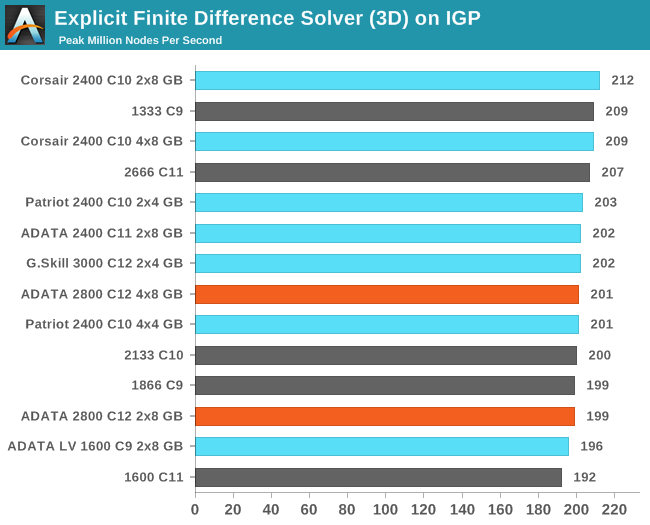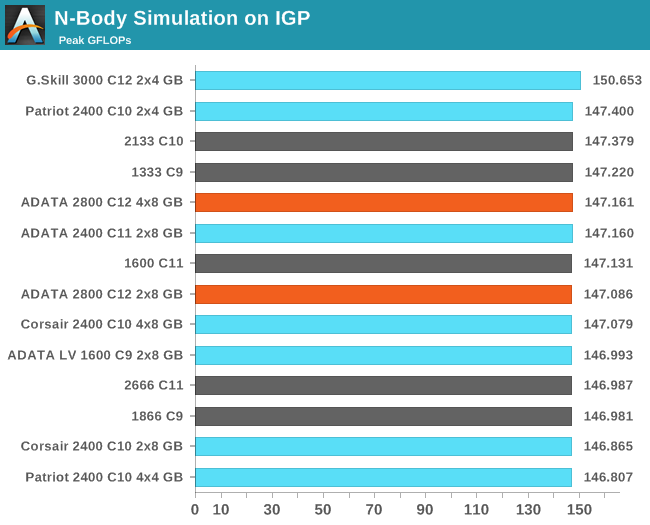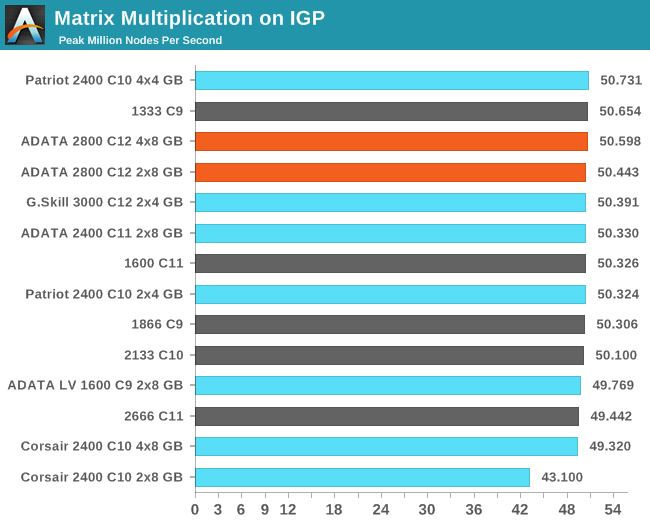ADATA XPG V2 Review: 2x8 GB at DDR3-2800 12-14-14 1.65 V
by Ian Cutress on December 17, 2013 12:00 PM ESTIGP Compute
One of the touted benefits of Haswell is the compute capability afforded by the IGP. For anyone using DirectCompute or C++ AMP, the compute units of the HD 4600 can be exploited as easily as any discrete GPU, although efficiency might come into question. Shown in some of the benchmarks below, it is faster for some of our computational software to run on the IGP than the CPU (particularly the highly multithreaded scenarios).
Grid Solvers - Explicit Finite Difference on IGP
As before, we test both 2D and 3D explicit finite difference simulations with 2n nodes in each dimension, using OpenMP as the threading operator in single precision. The grid is isotropic and the boundary conditions are sinks. We iterate through a series of grid sizes, and results are shown in terms of ‘million nodes per second’ where the peak value is given in the results – higher is better.


N-Body Simulation on IGP
As with the CPU compute, we run a simulation of 10240 particles of equal mass - the output for this code is in terms of GFLOPs, and the result recorded was the peak GFLOPs value.

3D Particle Movement on IGP
Similar to our CPU Compute algorithm, we calculate the random motion in 3D of free particles involving random number generation and trigonometric functions. For this application we take the fastest true-3D motion algorithm and test a variety of particle densities to find the peak movement speed. Results are given in ‘million particle movements calculated per second’, and a higher number is better.

Matrix Multiplication on IGP
Matrix Multiplication occurs in a number of mathematical models, and is typically designed to avoid memory accesses where possible and optimize for a number of reads and writes depending on the registers available to each thread or batch of dispatched threads. He we have a crude MatMul implementation, and iterate through a variety of matrix sizes to find the peak speed. Results are given in terms of ‘million nodes per second’ and a higher number is better.











19 Comments
View All Comments
Khenglish - Tuesday, December 17, 2013 - link
Your tRFC and tRRD rows are flipped in the table on the first page.That tRFC is ridiculously high. Cut it by 150-200 in XTU (yes, by up to 200. It's that ridiculously high) and you'll see around a 500MB/s bandwidth improvement. For reference I've run 2133 CAS9 stable at tFRC 128 in a laptop.
Also it would be nice to see results on an IVB system as well as Haswell. IVB is just as good at the top end, but I've seen signs that haswell has a better IMC, so while this memory is stable on haswell, it might not be on IVB. Also most people still have an IVB or SB anyway.
Gen-An - Wednesday, December 18, 2013 - link
You can't cut the tRFC by much on these, they use 4Gbit Hynix H5TQ4G83MFR ICs, and especially not at the high clocks they're running. It's going to be over 200 at about any speed, and you pretty much have to run it at 396 or so for 2933.Hairs_ - Tuesday, December 17, 2013 - link
Can we please stop this series of articles now? please?jasonelmore - Tuesday, December 17, 2013 - link
yeah enough with the RAM reviews. we've been on DDR3 for almost 10 years,Jeffrey Bosboom - Tuesday, December 17, 2013 - link
The only explanation I can think of for all these RAM reviews is that in exchange for samples, Anandtech is obligated to provide brand exposure. Otherwise there'd just be one roundup saying "yeah, they're all about the same". If that's the case, I feel sorry for Ian, who surely has better things to do with his time.Navvie - Wednesday, December 18, 2013 - link
This is what I figured, the original article was quite interesting. But this is really scraping the bottom of the barrel for article ideas.DanNeely - Wednesday, December 18, 2013 - link
Gotta agree. At most this should be a twice a year round up; maybe only once yearly depending on how frequently binning changes switch out which clock/cl combinations offer the best bang for the buck.Gen-An - Wednesday, December 18, 2013 - link
Ian, you state these sticks are using Hynix CFR, but CFR is a 2Gbit IC, it'd be impossible to make an 8GB DIMM with them. This has to be Hynix 4Gbit MFR.ceomrman - Tuesday, December 31, 2013 - link
Hmmm... couldn't this article just say "premium RAM is a hoax. Just buy some decent sticks from a known brand with plenty of 4 or 5 Egg reviews, and go with 1866 MHz if your motherboard will support it. Go ahead and buy faster RAM, but don't spend much since the performance impact is not noticeable in the real world."There are zero users who would not benefit more from some other use of the money, either in their savings account or in the form of a bigger SSD, nicer motherboard, more efficient PSU, faster CPU, etc.
Dog + pony show = Blech.